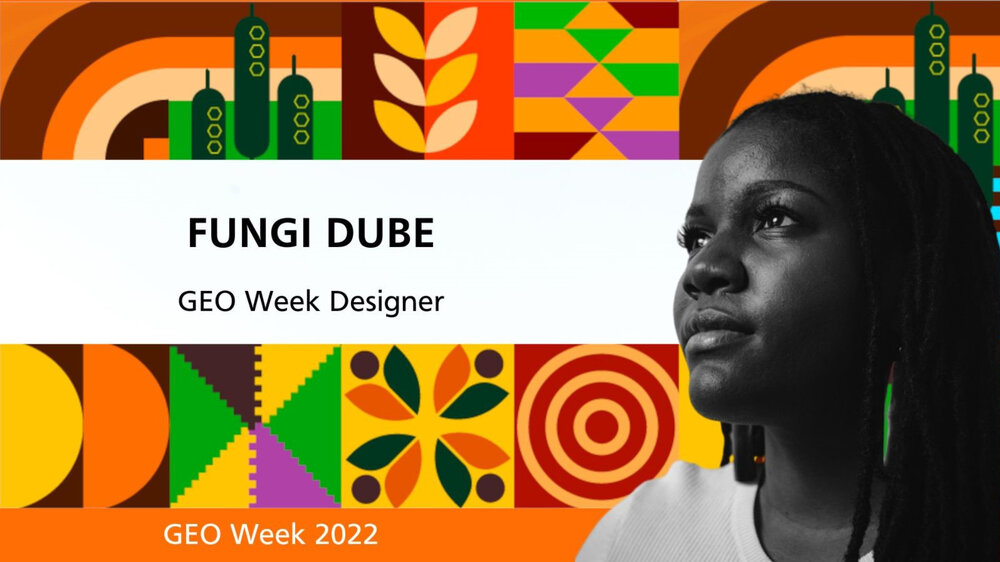Meet Fungi Dube, GEO Week designer

Ahead of GEO Week 2022 in Ghana, we spoke to Fungi Dube, creator of the designs for the event, to find out more about her inspiration, background and hopes for the future.
Q: What inspired your designs for GEO week and GEO Blue Planet symposiums?
A: The visual identity for the GEO Week and GEO Blue Planet Symposium for 2022 was inspired by Kente fabric, the regal cloth of Ghana. Kente fabric is made up of individually woven strips that are then joined together, with each telling its own unique story. To me, the visual language comprises a mosaic pattern style that incorporates elements that speak to biodiversity, urban development, agriculture, the ocean, and the coast—in line with GEO’s focus on sustainability and the planet.
The design language also features specific aspects of Ghanaian culture, like the weave patterns in Kente and some Adinkra symbols that were designed by the Akan people. The symbols are aphorisms that generally bear meaning towards unity, collaboration, wholesomeness, and innovation. Collectively, each square tells its own unique story.
Furthermore, the background design for GEO Week features topographical lines that are a nod to Earth observations systems. The Blue Planet background has hints of the ocean and water bubbles, underlining GEO’s work to protect life on land and life below water.
Q: What is your background and how did you become the creative designer you are today?
A: I have always had creative inclinations from childhood, however, tapping into my creative side as a young adult was purely circumstantial. I graduated with a BSc. in Human Anatomy & Physiology and Biochemistry from the University of Cape Town. I decided to teach myself a new skill to curb the frustration of job hunting after graduating. It was such a trying time because I was receiving many rejection e-mails, so Photoshop became my saving grace. I taught myself solely via YouTube.
I eventually landed a formal job in the education sector, but the design bug had already bit me! I would work for my employer during the day and continue learning other Adobe software at night. In 2015, about a year into my design journey and after gaining some confidence from designing experimental digital cards for my family, I landed my first corporate client and decided to turn design into my side hustle.
I have since become a full-time creative entrepreneur and am approaching my second anniversary soon. I left my former job in December of 2020. And, as risky and as bold as it was, I could not be happier!
On a personal note, I am an ardent Pan-Afrikanist! This means that I am passionate about elevating African narratives—regardless of their origin on the continent—through modern identity design systems. It also then follows that I am just as passionate about nurturing and cultivating multi-Afro-positive sentiments.
I believe that the African narrative may have been misconstrued along the way and that there has been a general external imposition on what design should look like. With each design and each story I get to tell, I am increasingly challenged and driven to showcase not only what design can look like, but also to convey the African story in its fullest grace and with the reverence that it deserves.
Q: What is your relationship with climate action and environmental protection?
A: This was my first project in the international development and climate action space, but it is definitely not my last. I was excited to work with GEO because I knew it would be an amazing collaboration. I was especially eager to capture the essence of GEO’s core objectives in a modern, Afro-inspired way.
Additionally, I was thrilled to apply my skills toward the broader cause of environmental protection—something that is important to me and I try to contribute to daily in my own little way. For instance, I harvest water from showers to water my potted plants. I work to reduce littering in my community, and I consciously try to avoid single-use plastics.
To this end, I hope that my work plays a small role in helping advance GEO’s ambitious goals. As human beings, we are inherently visual creatures. We often rely on visual cues to interpret our environment. Effective designs can create a functional, aesthetic, and emotional experience that the viewer can connect and engage with.
Q: What do you hope comes out of GEO Week and how can your designs contribute to that desired outcome?
A: Organizations like GEO, that work with such a wide range of audiences and stakeholders, can be better positioned when more people are inspired by and connect with the the physical environment of the convening. I also hope that the visuals reinforce some of GEO’s core values and objectives, all while keeping the audience engaged and challenged.
And with GEO Week taking place in Ghana, and hosting representatives from across the continent and the world, I wanted an African-focused design concept for a global audience. With 54 African countries, African design cannot be limited to a single aesthetic or singular history—it is multifaceted and multi-directional.
My hope is that there will be a deeper acknowledgement and overall curiosity of African traditional craft and symbolism, along with a deeper understanding of how it can and has played a significant role toward influencing visual communication on a global scale.